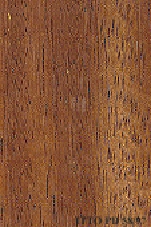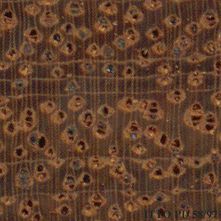
MERBAU (Intsia palembanica)
Trade Name
Merbau
Scientific Name
Intsia palembanica Miq.
Family
LEGUMINOSAE
Common Names
Vesi; V`ula; Tat-talun; Miraboo laut; Miraboo; Marbau; Makhamong; Lumpho; Lumpha; Lum-pho; Go nuoe; Borneo teak; Anglai; Merbau (United Kingdom); Lum-paw (Thailand); Moluccan ironwood (United Kingdom); Merbau (Netherlands); Kalabau (China); Kwila (Australia); Hintsy (Madagascar); Komu (New Caledonia); Kwila (Papua New Guinea); Gonuo (Vietnam); Ipil laut (Philippines); Ipil (Philippines); Merbau (Sarawak); Merbau (Indonesia); Mirabow (Sabah)
Scientific Name Synonyms
Afzelia palembanica Baker
Description Of The Tree
Botanical Description
It is a medium-sized or large tree up to 50 m tall. The bole is branchless for up to 22 m and up to 150 cm in diameter.
Natural Habitat
Intsia palembanica often occurs near the coast, but it is also found inland, up to 1,000 m of altitude. It is common in lowland forests, in transitional zones behind mangroves.
Natural Distribution
It is distributed in the Indo-Malayan region, Indonesia, Philippines, and many of the western Pacific islands as well as in Australia.
Plantations Available?
Plantations of "Merbau" are reported.
Non Timber Uses
Merbatu timber is reported to stain black in presence of iron.
Wood Identification
Anatomic Description Of Wood
Vessels per mm2 less than 6 (rare). Colored deposits in heartwood vessels. Tangential diameter of vessel lumina 200 micras or more (large). Vessel-ray pits similar to intervessel pits in size and shape. Simple perforation plates. Intervessel pits small, 7 micr Axial parenchyma aliform. Axial parenchyma confluent. Axial parenchyma in narrow bands on lines up to 3 cells wide. Homogeneous rays and/or sub-homogeneous rays (all ray cells procumbent). Occasionally body ray cells procumbent with one row of upright and/or square marginal cells (Kribs-III). Fibers with distinctly bordered pits.
-
 Wood Macro Photo Radial Plane
Wood Macro Photo Radial Plane
-
 Wood Micro Photo Of Transversal Section
Wood Micro Photo Of Transversal Section
Availability
Cites Status
Unrestricted
General Wood Description
Odor
Freshly-cut wood has persistent characteristic smell and bitter taste.
Color
The sapwood is clearly differentiated, lighter pale yellow. The heartwood varies from brownish gray through bronze to dark brown, darkening.
COLOR INDEX (1=Black, 7=Light yellow,white)
3
Grain
It is not always straight, occasionally interlocked.
Texture
It is coarse and homogeneous.
Luster
The sapwood has somewhat greenish luster.
Natural Durability
It is very durable, but the sapwood is vulnerable to the fungi and insect attack.
Natural durability index (1= Very high durability, 7=Vey low durability)
2
Silica Content
Silica Content: It is non-siliceous. Silica Value: 0
Resistance To Impregnation
The heartwood is reported to be very difficult to treat with preservatives.
Wood Physical Properties
Basic Density or Specific Gravity (O.D. weight/vol. green) (g/cm³)
0.71
Air-dry Density (Weight and volume at 12%MC) (g/cm³)
0.80
Total shrinkage Tangential (Saturated to 0%MC) (%)
5.0
Total shrinkage Radial (Saturated to 0%MC) (%)
3.0
Drying Defects
Ease of Drying: The wood of Kasai is difficult to dry, with considerable degrade unless handled with care. Drying Defects: The timber is liable to warp and collapse during drying due to excessive shrinkage.
Recommended Dry Kiln Schedule
UK-C; US-T3-C2; JP-35
Dimensional stability ratio (Total Tangential Shrinkage %/Total Radial Shrinkage %)
1.7
Wood Chemical Properties
Wood Mechanical Properties
Bending Strength (MOR),12%MC (kgf/cm²)
1273
Stiffness (MOE) 12%MC (kgf/cm²)
159196
Compression parallel to fiber 12%MC (kgf/cm²)
638
Compression perpendicular to fiber 12%MC (kgf/cm²)
92
Shear strength radial 12%MC (kgf/cm²)
127
Janka hardness (side) 12%MC (kgf)
678
Janka hardness (end grain) 12%MC (kgf)
593
Workability
Sawing
Sawing of this wood is reported to be fair to difficult. During sawmilling, the teeth might become covered with gums.
Rotary Veneer Cutting
Lamination of this species is possible but not recommended due to its high density.
Sliced Veneer
Lamination of this species is possible but not recommended due to its high density.
Blunting Effect
Dulling of cutting tools is moderate.
Machining
Machining operations are fair to difficult.
Planing
A reduction of the cutting angle to 20 degrees is advantageous in planing quarter-sawn material with interlocked grain and to prevent picking-up of grain.
Turning
30
Boring
This species is easy to bore.
Nailing
This species is reported to have a poor nailing behavior.
Gluing
It has a good behavior in gluing.
Finishing
The response of this species in finishing is good to fair. It has to be protected from humidity until the finishing operations are completed.
Staining
Wood of this species is easy to stain.
Polishing
The wood stains and polishes satisfactorily, but requires considerable filling.
REFERENCED USES
End Uses Summary
EXTERIOR GENERAL, bridges, poles, crossties, HOUSING GENERAL, flooring, frames, steps, panelling, FURNITURE AND CABINETS, PLYWOOD AND VENEER, TURNING, SPORTS, TOOLS, tool handles, agricultural tools, PACKING, CONTAINERS, chemical storage, truck bodies, truck flooring, NAVAL CONSTRUCTION, OTHER AND MUSICAL INSTRUMENTS, handicrafts
Exterior General
- 1 - Tabela de resultados de ensaios fisicos e mecanicos
Bridges
- 2 - 25 madeiras da amazonia de valor comercial, caracterizacao, macroscopica, usos comuns e indices qualificativos
Poles
- 3 - Estudo dendrologico e determinacao das caracteristicas fisicas e mecanicas do genipapo (Genipa americana)
Crossties
- 8 - Maderas latinoamericas. III, Podocarpus standleyi ,Podocarpus oleifolius, Drims granadensis, Magnolia poasana y Didymopanax pittieri
General Housing
- 10 - Silica in Timbers
Flooring
- 14 - Handbook of Hardwoods
Frames
- 16 - Woods of the World
Steps
- 17 - Tree Conservation Database
Paneling
- 18 - W3TROPICOS Missouri Botanical Garden
Furniture Cabinets
- 21 - Tropical timbers of the world. Part III-Southeast Asian and Oceanian Species.
Panels, Veneers
- 25 - Directory of Timber Trade Malaysia
Turning
- 30 - Embassy of Honduras in Japan
Sports
- 38 - Annual Review and Assessment of the World Timber Situation 1998-ITTO
Tools
- 42 - Utilización Industrial de Nuevas Especies Forestales en el Perú.
Tool Handles
- 43 - Maderas de Bolivia (Características y Usos de 55 Maderas Tropicales)
Agricultural Tools
- 44 - Atlas of Peruvian Woods
Packing
- 45 - Recopilación y Análisis de Estudios Tecnológicos de Maderas Peruanas
Containers
- 50 - Properties of imported tropical woods
Chemical Storage
- 52 - Propiedades mecanicas y asociadas del pino insigne (Pinus radiata d.don)
Truck Body
- 53 - Timbers of the New World
Truck Flooring
- 54 - Bulletin of the Government Forest Experiment Station N.157: Identification of Tropical Woods
Shipbuilding
- 55 - Tropical Timber Atlas of Latin America
Other & Musical Instruments
- 63 - Madeiras do Brazil II
Handcraft
- 66 - Maderas latinoamericanas. VII. Caracteristicas anatomicas. propiedades fisicomecanicas, de secado, y tratabilidad de la madera juvenil de Cordia alliodora (Ruiz & Pav. Oken.)
Please Provide Information To View Producer Information